odometer Mercury Grand Marquis 1011 Owner's Manuals
[x] Cancel search | Manufacturer: MERCURY, Model Year: 1011, Model line: Grand Marquis, Model: Mercury Grand Marquis 2011Pages: 333, PDF Size: 2.23 MB
Page 18 of 333
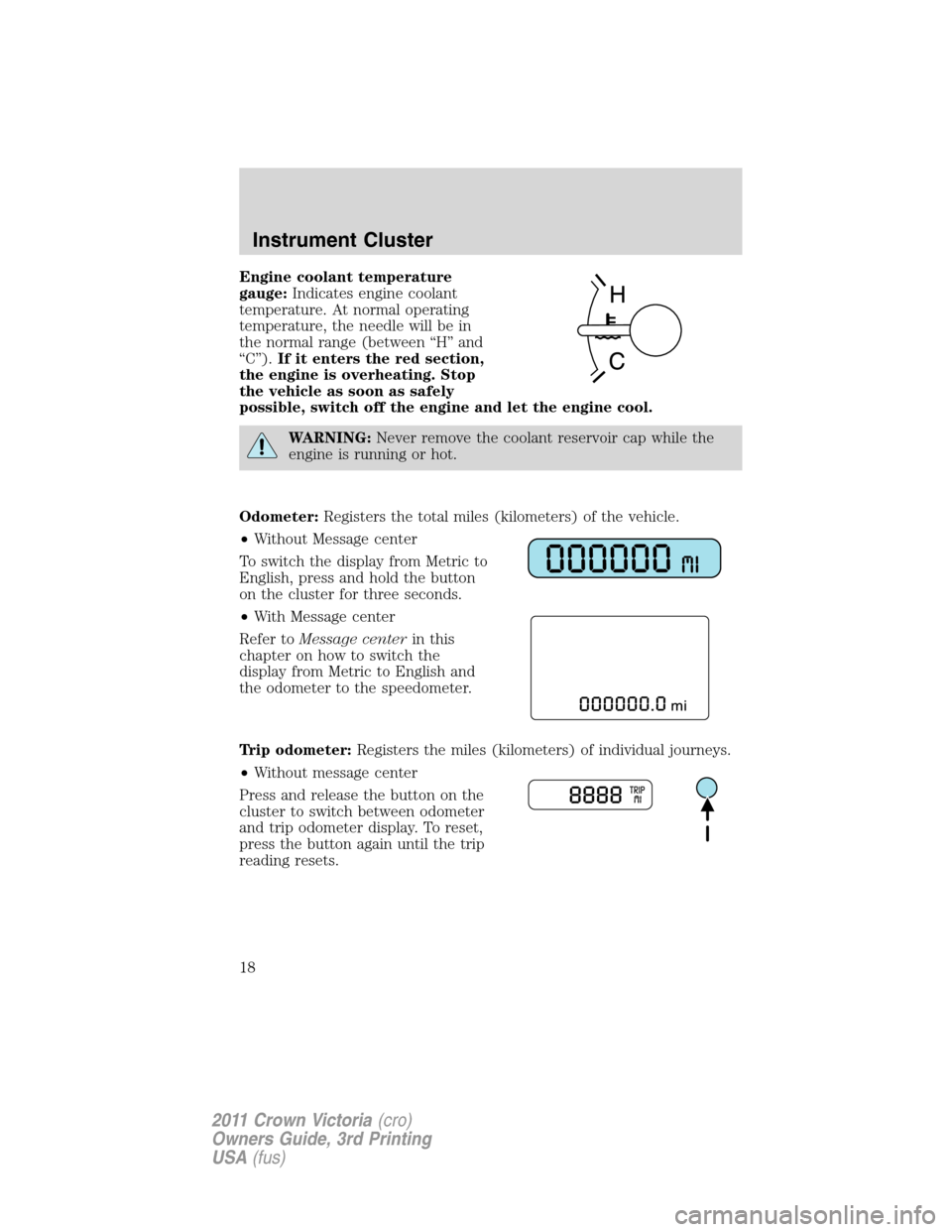
Engine coolant temperature
gauge:Indicates engine coolant
temperature. At normal operating
temperature, the needle will be in
the normal range (between “H” and
“C”).If it enters the red section,
the engine is overheating. Stop
the vehicle as soon as safely
possible, switch off the engine and let the engine cool.
WARNING:Never remove the coolant reservoir cap while the
engine is running or hot.
Odometer:Registers the total miles (kilometers) of the vehicle.
•Without Message center
To switch the display from Metric to
English, press and hold the button
on the cluster for three seconds.
•With Message center
Refer toMessage centerin this
chapter on how to switch the
display from Metric to English and
the odometer to the speedometer.
Trip odometer:Registers the miles (kilometers) of individual journeys.
•Without message center
Press and release the button on the
cluster to switch between odometer
and trip odometer display. To reset,
press the button again until the trip
reading resets.
Instrument Cluster
18
2011 Crown Victoria(cro)
Owners Guide, 3rd Printing
USA(fus)
Page 22 of 333
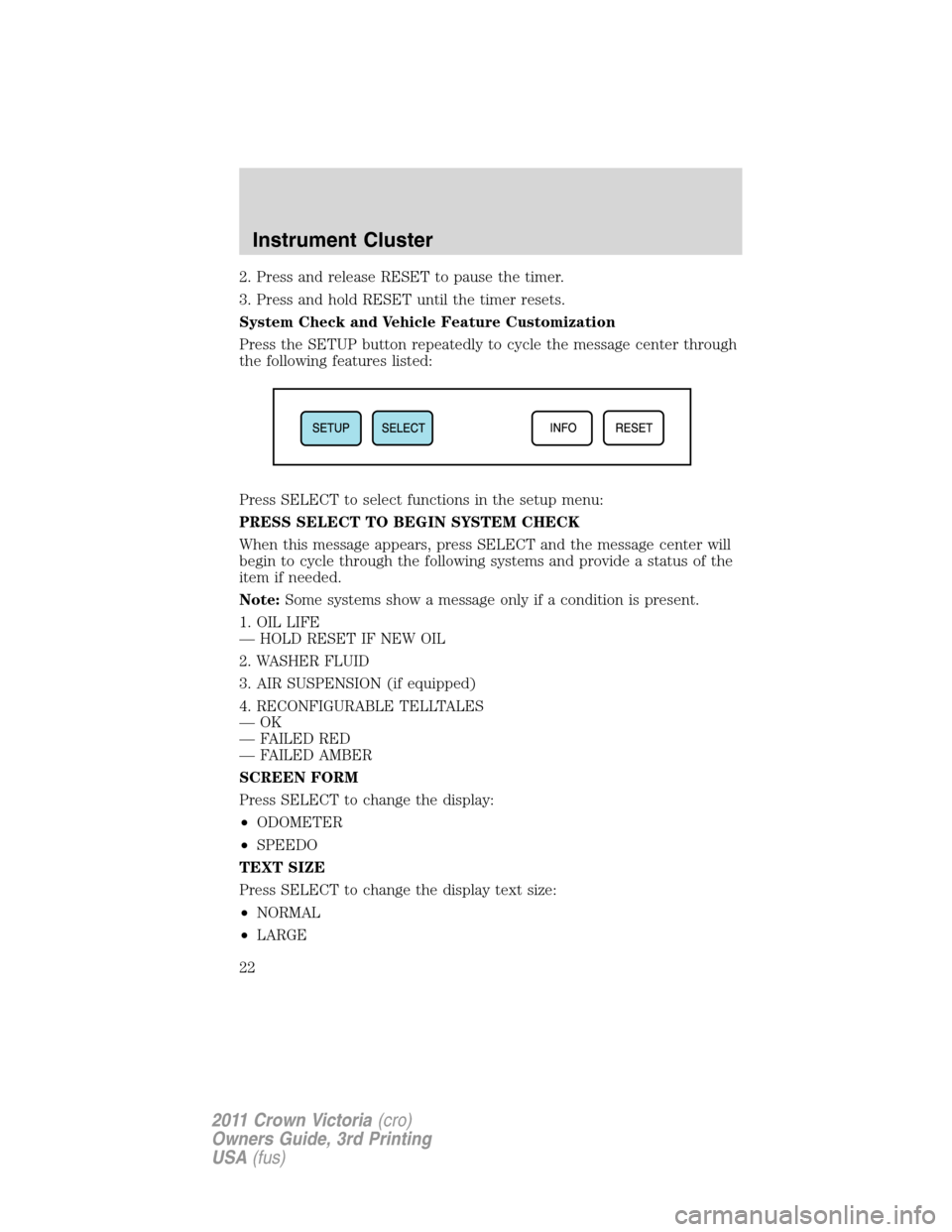
2. Press and release RESET to pause the timer.
3. Press and hold RESET until the timer resets.
System Check and Vehicle Feature Customization
Press the SETUP button repeatedly to cycle the message center through
the following features listed:
Press SELECT to select functions in the setup menu:
PRESS SELECT TO BEGIN SYSTEM CHECK
When this message appears, press SELECT and the message center will
begin to cycle through the following systems and provide a status of the
item if needed.
Note:Some systems show a message only if a condition is present.
1. OIL LIFE
— HOLD RESET IF NEW OIL
2. WASHER FLUID
3. AIR SUSPENSION (if equipped)
4. RECONFIGURABLE TELLTALES
—OK
— FAILED RED
— FAILED AMBER
SCREEN FORM
Press SELECT to change the display:
•ODOMETER
•SPEEDO
TEXT SIZE
Press SELECT to change the display text size:
•NORMAL
•LARGE
Instrument Cluster
22
2011 Crown Victoria(cro)
Owners Guide, 3rd Printing
USA(fus)
Page 214 of 333
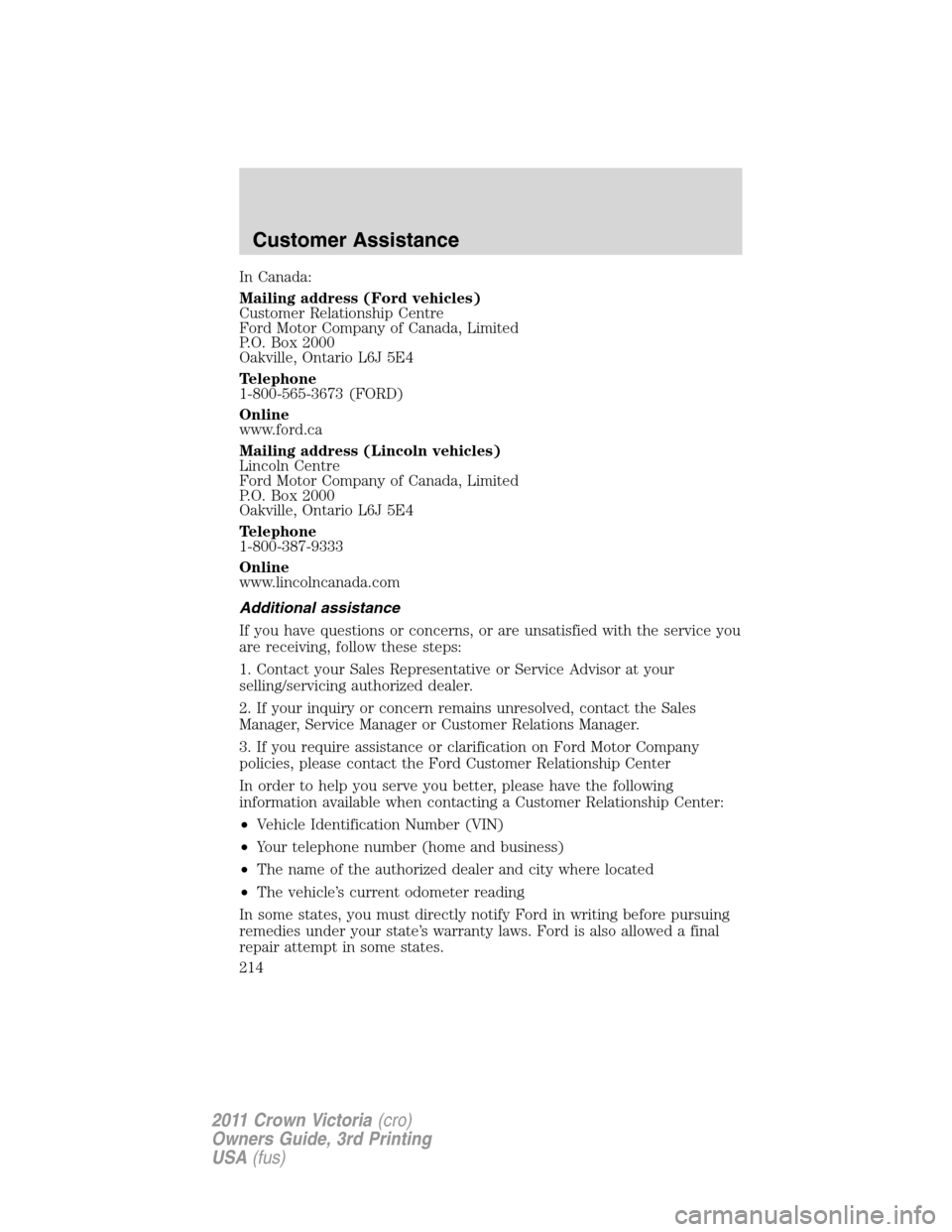
In Canada:
Mailing address (Ford vehicles)
Customer Relationship Centre
Ford Motor Company of Canada, Limited
P.O. Box 2000
Oakville, Ontario L6J 5E4
Telephone
1-800-565-3673 (FORD)
Online
www.ford.ca
Mailing address (Lincoln vehicles)
Lincoln Centre
Ford Motor Company of Canada, Limited
P.O. Box 2000
Oakville, Ontario L6J 5E4
Telephone
1-800-387-9333
Online
www.lincolncanada.com
Additional assistance
If you have questions or concerns, or are unsatisfied with the service you
are receiving, follow these steps:
1. Contact your Sales Representative or Service Advisor at your
selling/servicing authorized dealer.
2. If your inquiry or concern remains unresolved, contact the Sales
Manager, Service Manager or Customer Relations Manager.
3. If you require assistance or clarification on Ford Motor Company
policies, please contact the Ford Customer Relationship Center
In order to help you serve you better, please have the following
information available when contacting a Customer Relationship Center:
•Vehicle Identification Number (VIN)
•Your telephone number (home and business)
•The name of the authorized dealer and city where located
•The vehicle’s current odometer reading
In some states, you must directly notify Ford in writing before pursuing
remedies under your state’s warranty laws. Ford is also allowed a final
repair attempt in some states.
Customer Assistance
214
2011 Crown Victoria(cro)
Owners Guide, 3rd Printing
USA(fus)
Page 251 of 333
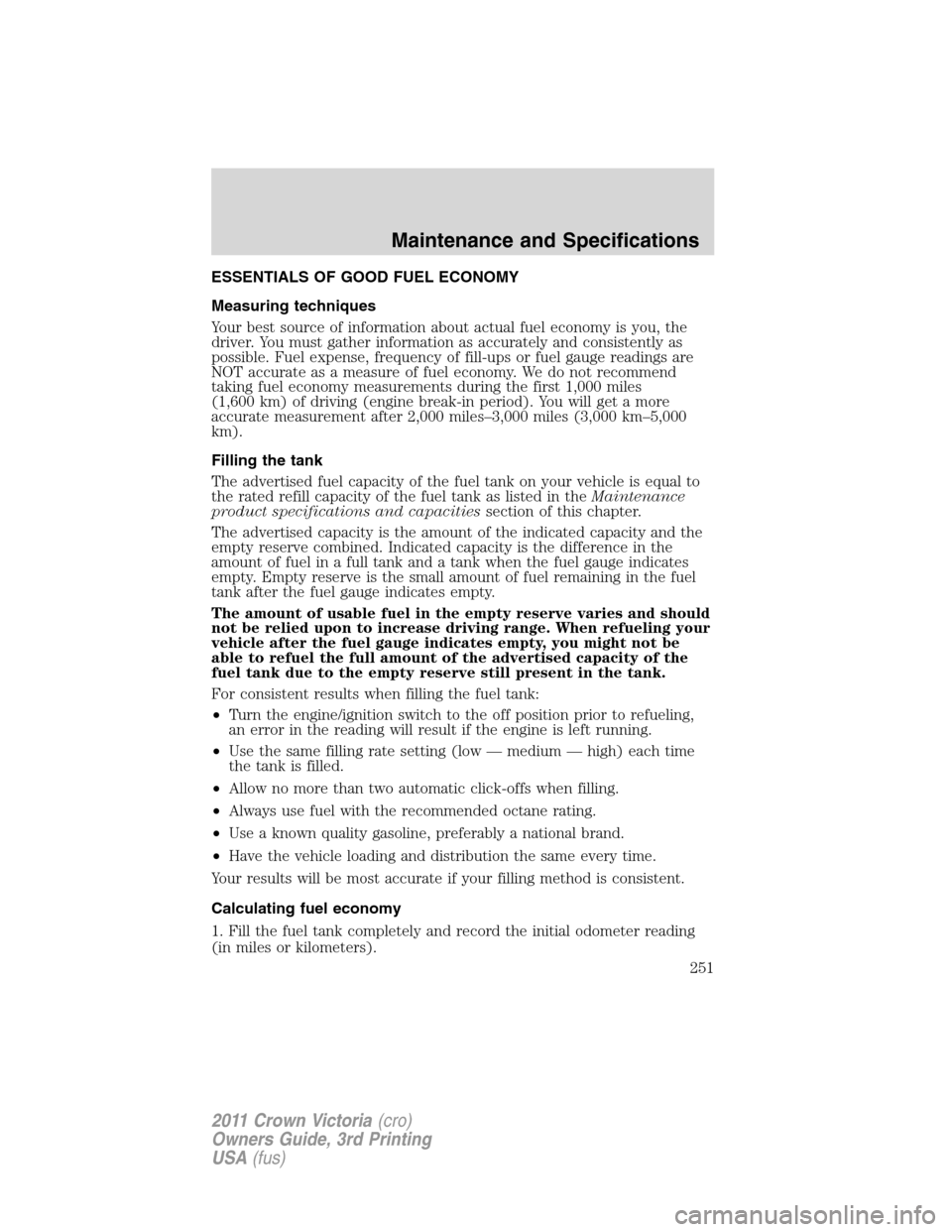
ESSENTIALS OF GOOD FUEL ECONOMY
Measuring techniques
Your best source of information about actual fuel economy is you, the
driver. You must gather information as accurately and consistently as
possible. Fuel expense, frequency of fill-ups or fuel gauge readings are
NOT accurate as a measure of fuel economy. We do not recommend
taking fuel economy measurements during the first 1,000 miles
(1,600 km) of driving (engine break-in period). You will get a more
accurate measurement after 2,000 miles–3,000 miles (3,000 km–5,000
km).
Filling the tank
The advertised fuel capacity of the fuel tank on your vehicle is equal to
the rated refill capacity of the fuel tank as listed in theMaintenance
product specifications and capacitiessection of this chapter.
The advertised capacity is the amount of the indicated capacity and the
empty reserve combined. Indicated capacity is the difference in the
amount of fuel in a full tank and a tank when the fuel gauge indicates
empty. Empty reserve is the small amount of fuel remaining in the fuel
tank after the fuel gauge indicates empty.
The amount of usable fuel in the empty reserve varies and should
not be relied upon to increase driving range. When refueling your
vehicle after the fuel gauge indicates empty, you might not be
able to refuel the full amount of the advertised capacity of the
fuel tank due to the empty reserve still present in the tank.
For consistent results when filling the fuel tank:
•Turn the engine/ignition switch to the off position prior to refueling,
an error in the reading will result if the engine is left running.
•Use the same filling rate setting (low — medium — high) each time
the tank is filled.
•Allow no more than two automatic click-offs when filling.
•Always use fuel with the recommended octane rating.
•Use a known quality gasoline, preferably a national brand.
•Have the vehicle loading and distribution the same every time.
Your results will be most accurate if your filling method is consistent.
Calculating fuel economy
1. Fill the fuel tank completely and record the initial odometer reading
(in miles or kilometers).
Maintenance and Specifications
251
2011 Crown Victoria(cro)
Owners Guide, 3rd Printing
USA(fus)
Page 252 of 333

2. Each time you fill the tank, record the amount of fuel added (in
gallons or liters).
3. After at least three to five tank fill-ups, fill the fuel tank and record
the current odometer reading.
4. Subtract your initial odometer reading from the current odometer
reading.
5. Follow one of the simple calculations in order to determine fuel
economy:
Calculation 1:Divide total miles traveled by total gallons used.
Calculation 2:Multiply liters used by 100, then divide by total
kilometers traveled.
Keep a record for at least one month and record the type of driving (city
or highway). This will provide an accurate estimate of the vehicle’s fuel
economy under current driving conditions. Additionally, keeping records
during summer and winter will show how temperature impacts fuel
economy. In general, lower temperatures give lower fuel economy.
Driving style — good driving and fuel economy habits
Give consideration to the lists that follow and you may be able to change
a number of variables and improve your fuel economy.
Habits
•Smooth, moderate operation can yield up to 10% savings in fuel.
•Steady speeds without stopping will usually give the best fuel
economy.
•Idling for long periods of time (greater than one minute) may waste
fuel.
•Anticipate stopping; slowing down may eliminate the need to stop.
•Sudden or hard accelerations may reduce fuel economy.
•Slow down gradually.
•Driving at reasonable speeds (traveling at 55 mph [88 km/h] uses 15%
less fuel than traveling at 65 mph [105 km/h]).
•Revving the engine before turning it off may reduce fuel economy.
•Using the air conditioner or defroster may reduce fuel economy.
•You may want to turn off the speed control in hilly terrain if
unnecessary shifting between the top gears occurs. Unnecessary
shifting of this type could result in reduced fuel economy.
Maintenance and Specifications
252
2011 Crown Victoria(cro)
Owners Guide, 3rd Printing
USA(fus)
Page 271 of 333
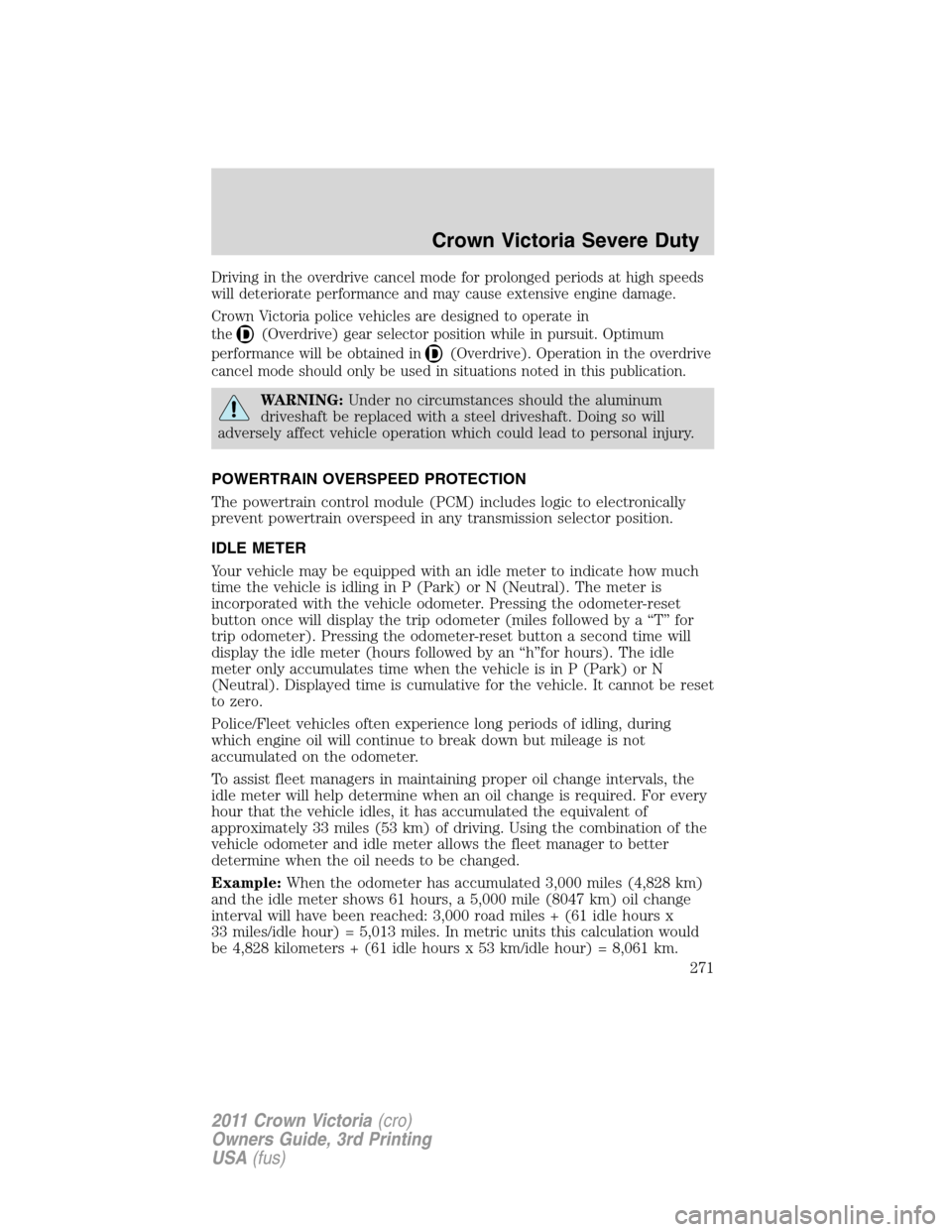
Driving in the overdrive cancel mode for prolonged periods at high speeds
will deteriorate performance and may cause extensive engine damage.
Crown Victoria police vehicles are designed to operate in
the
(Overdrive) gear selector position while in pursuit. Optimum
performance will be obtained in
(Overdrive). Operation in the overdrive
cancel mode should only be used in situations noted in this publication.
WARNING:Under no circumstances should the aluminum
driveshaft be replaced with a steel driveshaft. Doing so will
adversely affect vehicle operation which could lead to personal injury.
POWERTRAIN OVERSPEED PROTECTION
The powertrain control module (PCM) includes logic to electronically
prevent powertrain overspeed in any transmission selector position.
IDLE METER
Your vehicle may be equipped with an idle meter to indicate how much
time the vehicle is idling in P (Park) or N (Neutral). The meter is
incorporated with the vehicle odometer. Pressing the odometer-reset
button once will display the trip odometer (miles followed by a “T” for
trip odometer). Pressing the odometer-reset button a second time will
display the idle meter (hours followed by an “h”for hours). The idle
meter only accumulates time when the vehicle is in P (Park) or N
(Neutral). Displayed time is cumulative for the vehicle. It cannot be reset
to zero.
Police/Fleet vehicles often experience long periods of idling, during
which engine oil will continue to break down but mileage is not
accumulated on the odometer.
To assist fleet managers in maintaining proper oil change intervals, the
idle meter will help determine when an oil change is required. For every
hour that the vehicle idles, it has accumulated the equivalent of
approximately 33 miles (53 km) of driving. Using the combination of the
vehicle odometer and idle meter allows the fleet manager to better
determine when the oil needs to be changed.
Example:When the odometer has accumulated 3,000 miles (4,828 km)
and the idle meter shows 61 hours, a 5,000 mile (8047 km) oil change
interval will have been reached: 3,000 road miles + (61 idle hours x
33 miles/idle hour) = 5,013 miles. In metric units this calculation would
be 4,828 kilometers + (61 idle hours x 53 km/idle hour) = 8,061 km.
Crown Victoria Severe Duty
271
2011 Crown Victoria(cro)
Owners Guide, 3rd Printing
USA(fus)
Page 321 of 333
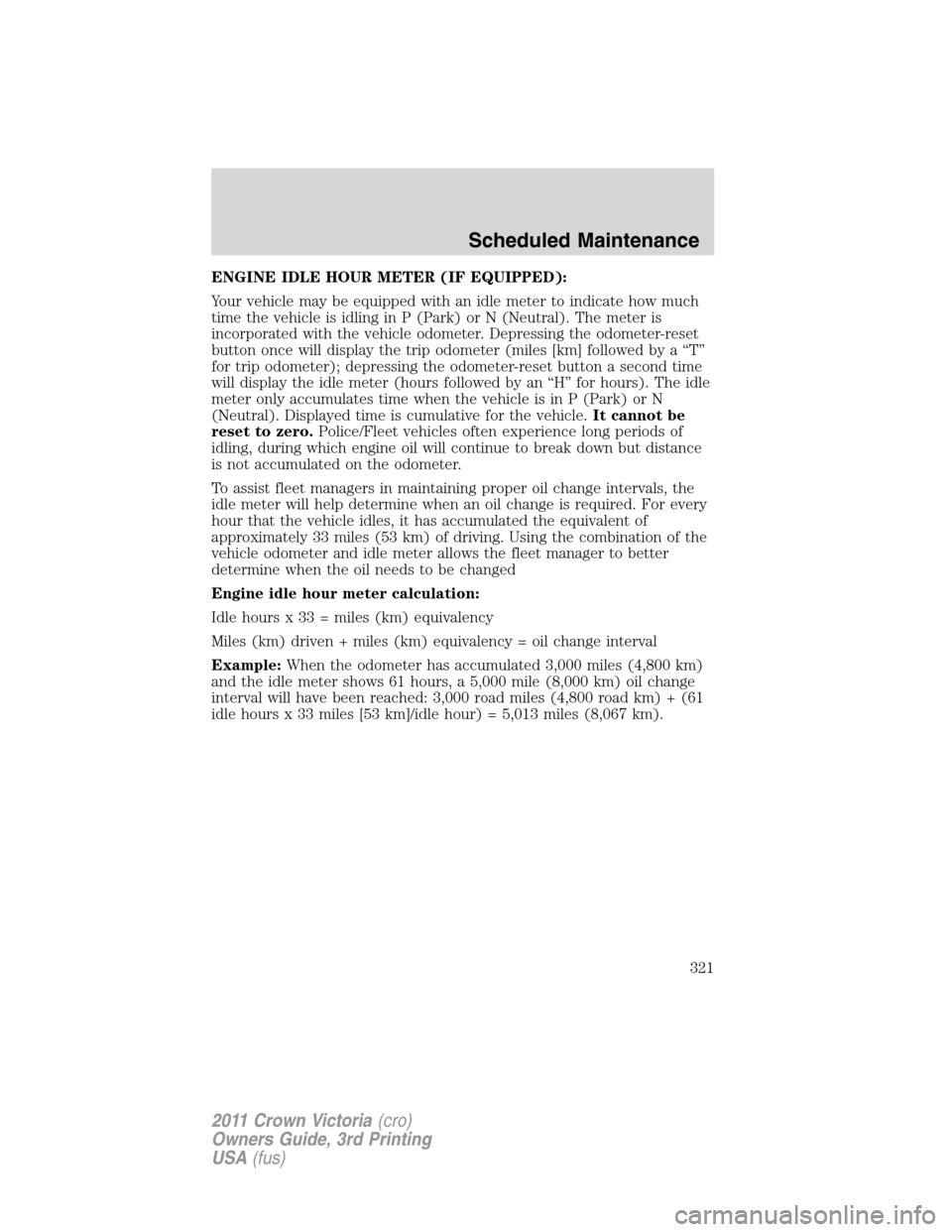
ENGINE IDLE HOUR METER (IF EQUIPPED):
Your vehicle may be equipped with an idle meter to indicate how much
time the vehicle is idling in P (Park) or N (Neutral). The meter is
incorporated with the vehicle odometer. Depressing the odometer-reset
button once will display the trip odometer (miles [km] followed by a “T”
for trip odometer); depressing the odometer-reset button a second time
will display the idle meter (hours followed by an “H” for hours). The idle
meter only accumulates time when the vehicle is in P (Park) or N
(Neutral). Displayed time is cumulative for the vehicle.It cannot be
reset to zero.Police/Fleet vehicles often experience long periods of
idling, during which engine oil will continue to break down but distance
is not accumulated on the odometer.
To assist fleet managers in maintaining proper oil change intervals, the
idle meter will help determine when an oil change is required. For every
hour that the vehicle idles, it has accumulated the equivalent of
approximately 33 miles (53 km) of driving. Using the combination of the
vehicle odometer and idle meter allows the fleet manager to better
determine when the oil needs to be changed
Engine idle hour meter calculation:
Idle hours x 33 = miles (km) equivalency
Miles (km) driven + miles (km) equivalency = oil change interval
Example:When the odometer has accumulated 3,000 miles (4,800 km)
and the idle meter shows 61 hours, a 5,000 mile (8,000 km) oil change
interval will have been reached: 3,000 road miles (4,800 road km) + (61
idle hours x 33 miles [53 km]/idle hour) = 5,013 miles (8,067 km).
Scheduled Maintenance
321
2011 Crown Victoria(cro)
Owners Guide, 3rd Printing
USA(fus)